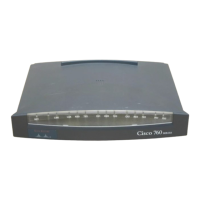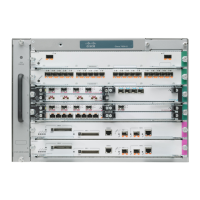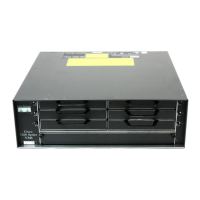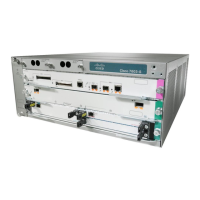A-4 Cisco 7010 Hardware Installation and Maintenance
Fast Ethernet Connector Signals
Fast Ethernet Connector Signals
The two connectors on the FEIP are a single MII, 40-pin, D-shell type, and a single RJ-45. You can
use either one or the other. Only one connector can be used at one time. Each connection supports
IEEE 802.3u interfaces compliant with the 100BaseX and 100BaseT standards. The RJ-45
connection does not require an external transceiver; however, the MII connection does.
The RJ-45 modular connector has strain-relief functionality incorporated into the design of its
standard plastic connector.Table A-4 and Table A-5 list the pinouts and signals for the RJ-45 and
MII connectors.
Table A-4 FEIP Port Adapter RJ-45 Connector Pinout
Note Referring to the RJ-45 pinout in Table A-4, proper common-mode line terminations should
be used for the unused Category 5, UTP cable pairs 4/5 and 7/8. Common-mode termination reduces
the contributions to electromagnetic interference (EMI) and susceptibility to common-mode
sources. Wire pairs 4/5 and 7/8 are actively terminated in the RJ-45, 100BaseTX port circuitry in the
FEIP port adapter.
Table A-5 FEIP Port Adapter MII Connector Pinout
Pin Description
1 Receive Data + (RxD+)
2RxD–
3 Transmit Data + (TxD+)
6TxD–
Pin
1
1. Any pins not indicated are not used.
In Out I/O Description
14–17 – Yes – Transmit Data (TxD)
12 Yes – – Transmit Clock (Tx_CLK)
2
2. Tx_CLK and Rx_CLK are provided by the external transceiver.
11 – Yes – Transmit Error (Tx_ER)
13 – Yes – Transmit Enable (Tx_EN)
3 – Yes – MII Data Clock (MDC)
4–7 Yes – – Receive Data (RxD)
9 Yes – – Receive Clock (Rx_CLK)
10 Yes – – Receive Error (Rx_ER)
8 Yes – – Receive Data Valid (Rx_DV)
18 Yes – – Collision (COL)
19 Yes – – Carrier Sense (CRS)
2 – – Yes MII Data Input/Output (MDIO)
22–39 – – – Common (ground)
1, 20, 21, 40 – – – +5.0 volts (V)

